While a dedicate page will be created at a later time giving more details concerning the dual Korean number systems for those who wish to learn Korean, this page you are currently reading is designed to give a few examples of Korean numbers that are helpful for everyone to know as they pertain to money and you'll come across them simply by using the currency. If you are curious on learning the Korean numerals to a deeper level, we recommend you check out the related Wikipedia page and other related pages linked within their contents. The website Talk to Me in Korean has multiple pages worth checking out; Sino-Korean numbers, native Korean numbers, and a paid audio course detailing the number systems.
As this is under the Banking category of this support website, this page will focus on knowing some terms to help you better understand currency. Different countries have different rules with commas and periods. As this website was written by a North American, let’s look at numbers as through this lens. The first digit can range from 0-9, then we have a unique system for the tens (ten, twenty, thirty, ...), but with the hundreds we start to get a simplified system; 1-9 and add the word hundred:
100 = one hundred (one group of a 100)
200 = two hundred (two groups of 100)
300 = three hundred (three groups of 100)
The system is more simplified once you break past the comma. The first example is with thousands:
1,000 = one thousand (one group of a 1,000)
2,000 = two thousand (two groups of 1,000)
10,000 = ten thousand (ten groups of 1,000)
20,000 = twenty thousand (twenty groups of 1,000)
100,000 = hundred thousand (100 groups of 1,000)
The same is true with millions are they come after the next comma:
5,000,000 = five million (five groups of 1,000,000)
25,000,000 = twenty-five million (twenty-five groups of 1,000,000)
320,000,000 = three hundred twenty million (320 groups of 1,000,000)
This system of going past a new comma = a new term continues from here with millions, billions, trillions, etc. Now we have established our (North American) baseline so we have something to compare it against.
There are two number systems in Korean, but once you get large numbers there is one system used and it doesn’t follow the commas like the examples above. While Korean has a term for thousand (천, 千, cheon) and you can add 1-9 in front, just like in English, the biggest number you can put in front of 천 is 9. This is also the value of the smallest bill of Korean currency, the 1,000 won bill and you'll also see the 5,000 won bill.
While these sample images show the bills are exactly the same width and height, in all actuality they are slightly different sized. The larger the value of the bill the larger its physical size, both width and height. It is also worth noting that there are no commas on any of the paper currency.
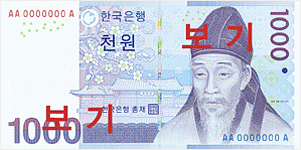
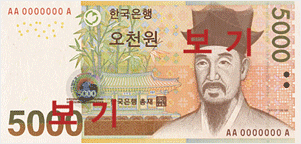
Then we have a new set of numbers; 만 (萬, man) for 10,000 and you can add 1-9 in front. This group of numbers you’ll see when paying for a taxi or going out for dinner.
만 = 10,000 = one group of 10,000
2만 = 20,000 = two groups of 10,000
3만 = 30,000 = three groups of 10,000
Now is a good time to say these are our next currency bills, the 10,000 and the newer 50,000 won notes. The 50,000 note is the largest paper currency in circulation, but bank cheques are usually 100,000 won. As stated before, the larger the value of the bill the larger its physical size, both width and height.
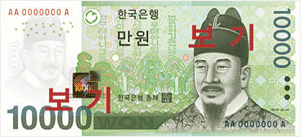
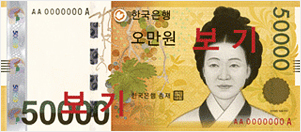
The 만 is more versatile that to be limited to only 1-9; we can add another digital in front as well, going from 10 to 99. This group of numbers you’ll see when related costs for a weekend trip or monthly rent.
10만 = 100,000 = 10 groups of 10,000
20만 = 200,000 = 20 groups of 10,000
99만 = 990,000 = 99 groups of 10,000
We can also do hundreds (백, 白, baek) in front of 만. This group of numbers you’ll see when thinking about monthly salary.
100만 = 1,000,000 = 100 units of 10,000
101만 = 1,010,000 = 101 units of 10,000
321만 = 3,210,000 = 321 units of 10,000
The 10,000 won note and the 50,000 note are the only notes that ATMs service. And ATMS are a big reason why I decided to create the page you are reading currently as well as a page dedicated to discussing ATMs. When you wish to withdraw cash from an ATM, you select how much money you wish to receive by clicking one of the default amounts listed or can enter a separate number by clicking the Others buttons. Note that in the middle of the screen it says (Unit: 10,000). This is the 만 (man) that we’ve been discussing.
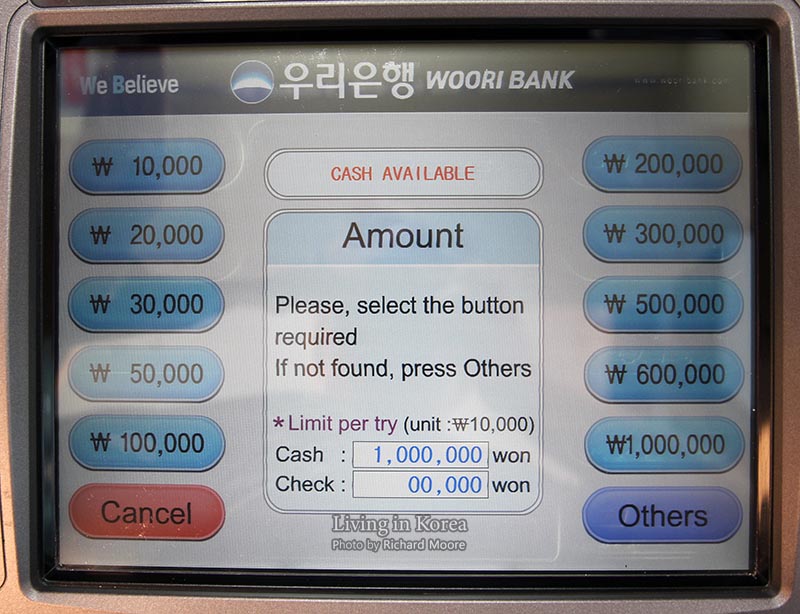
If you clicked the Others button you should see a screen similar to this. Again note that it says to “... enter withdrawal amount in 10,000 unit followed by the Man (button)”. For this example, I wish to withdraw 350,000 won, so I simply touch the 3 and 5 buttons.
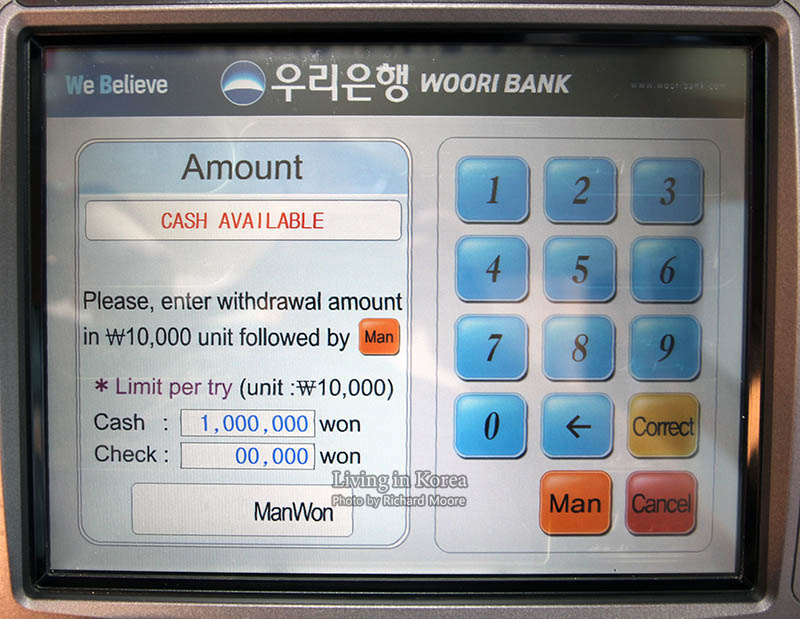
Now I see at the bottom it says 35 ManWon. Remember that 35만 = 350,000 which gets me the 350,000 won that I wish to receive. I click the Man button for 만 to get to the next screen.

Knowing 만 is useful on this screen as well ever since the 50,000 bill came into circulation in 2009 because you’ll need to tell the ATM how much of the 10,000 bills and how much of the 50,000 bills you want. It will default to all 10,000 bills. If that is fine, press the Confirm button to move on. But today I wanted a mix of denominations, so I pressed the numbers 2 0 for 200,000 won in 50,000 denominations which will be 4 bills. The remaining 150,000 won will come out in fifteen 10,000 bills.
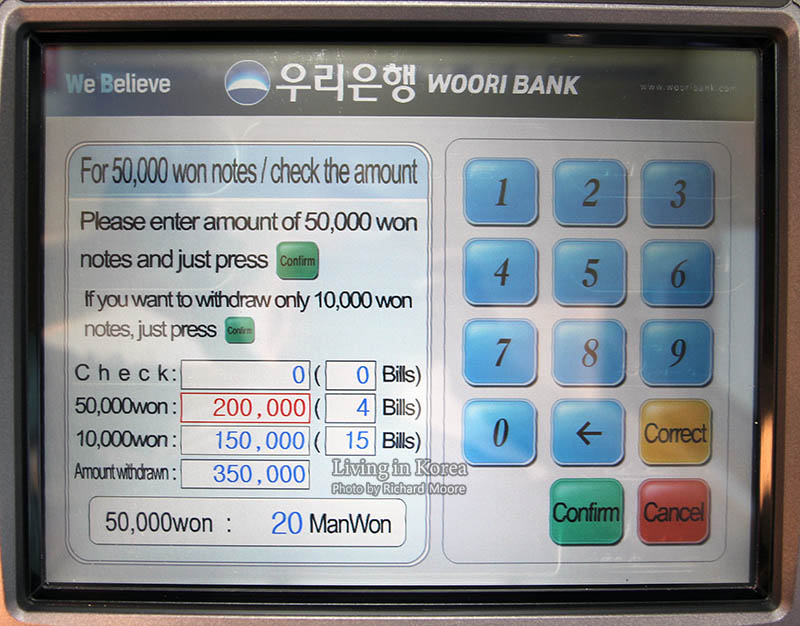
Did you think we were done with 만? No no no, we aren't done yet! We can also add thousands in front of 만. Remember the 천 from before? As 천 = thousand, we can also use that term in front of the familiar 만.
1,000만 (천만 or 1천1만) = 10,000,000 = one 1,000 groups of 10,000
2,000만 (2천만 or 2천1만) = 20,000,000 = two 1,000 groups of 10,000
3,040만 (3천40만) = 30,400,000 = three 1,000 groups of 10,000 and another 40 groups of 10,000
4,567만 (4천567만) = 45,670,000 = four 1,000 groups of 10,000 and another 567 groups of 10,000
We’ve reached the limit of our 만 and are forced to get a new term, 억 (億, eok). One unit of 억 = 100,000,000. This group of numbers you’ll see when you hear about the jeonse deposit for a residence. We can put 1-9 in front, we can put 10-99 in front, we can put hundreds (백), and we can also put thousands (천). If you want to go even farther, the next grouping of numbers is 조 (兆, jo) but it will be rare for you to see this number in practice and that is clearly out of the scope of this page.